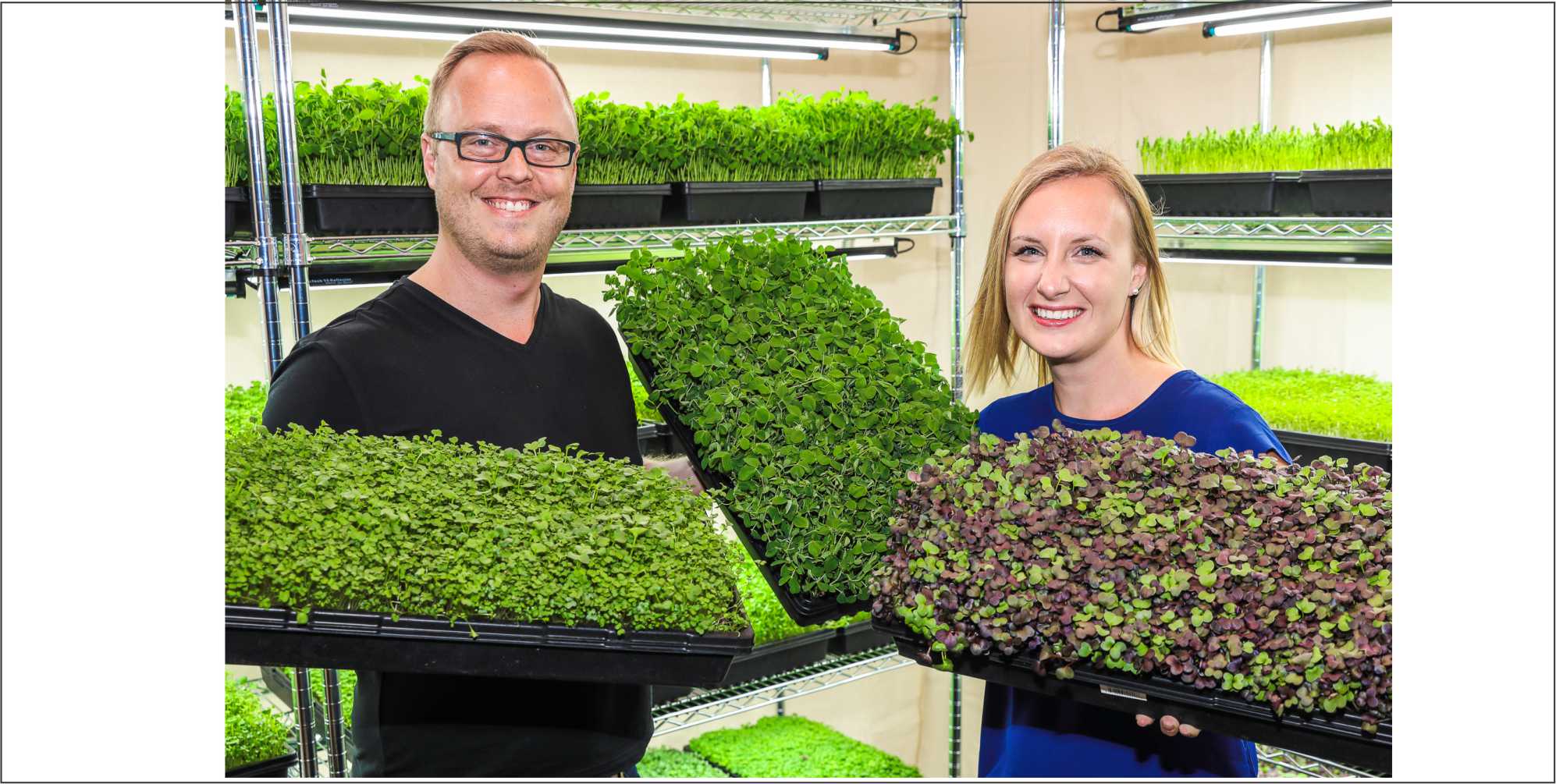“The advantage of microgreens is that you can gain a lot of nutritional value within a small amount … versus the full-grown version of the plant”
David and Kirstin Barchard run an urban microgreen farm that takes a different approach to agriculture. This issue, we catch up with David to find out more.
airdrielife: Describe your business.
David Barchard: We approach agriculture in an innovative way. Locally here in Airdrie, we grow in square feet, not acres. We use energy-efficient lighting and a climate-controlled environment to produce the freshest microgreens and shoots that can be on your plate within hours of harvest.
We’ve created a sustainable farm where the harvest cycle is days, not months. Our farm uses 90 per cent less water than traditional farming, is pesticide and herbicide free and is fresh year round. We also seek to educate on the health benefits of microgreens and how they can be a constant in a family’s weekly meal planning.
AL: What are microgreens?
DB: Microgreens are shoots of salad vegetables such as arugula, peas, mustard, broccoli, etc., picked just after the first leaves have developed. They’re smaller than baby greens and bigger than sprouts. Our microgreens germinate in soil, require light for growth and are harvested when they’re nine to 14 days old and two to three inches tall. Their flavour is much more intense than that of mature greens.
AL: What was your aha moment to start this business?
DB: Our aha moment was when we saw a gap in the food supply here in Calgary and Canada as a collective whole. We were in local farmers markets in the Calgary and surrounding area in midsummer and we still noticed veggies coming in from as far away as Mexico and California. These veggies could easily be grown locally and in many cases are, but not in the capacity they need to be in order to change how we as consumers view local food. We sought to create a company that can offer fresh, local produce 365 days a year at an approachable price that does not fluctuate based on season, and can be delivered directly to your door within hours of harvest.
AL: To whom do you currently supply microgreens?
DB: We currently supply to 22 establishments, four directly here in Airdrie: First & Vine, Sorso Espresso & Wine Bar, Oranj Fitness and Homegrown House & Pantry.
AL: Where can the consumer buy them?
DB: We sell direct from our farm, and consumers can contact us directly for orders. We harvest and deliver twice a week and offer free delivery within Airdrie.
Consumers can also buy direct from Homegrown House & Pantry as they stock a few of our products.
AL: What is the biggest challenge to your business?
DB: The biggest challenge we face is to work within an already established food supply environment. We grow dedicated crops for both our wholesale and retail clients which mean we seek to produce no extra waste. We want to essentially grow dedicated gardens available year round, that we can deliver to our clients, harvested day of. This poses a challenge as we need to grow enough to supply our weekly deliveries, yet not have too much excess, and yet take into account possible crop loss due to low germination, new seed lots and possible changes in temperature.
AL: How much do you grow each year?
DB: We grow approximately 2,300 pounds for restaurants, and 350 pounds for retail clients. We anticipate restaurants to double by the end of 2018, and retail clients will triple.
AL: How many varieties do you grow?
DB: We currently grow nine varietals: pea shoots; popcorn shoots; wheatgrass; radish; green kale; Genovese basil; Brassica mix (broccoli, rapini, mustard, radish, arugula); arugula; cilantro.
AL: What are some of the advantages of eating microgreens?
DB: The advantage of microgreens is that you can gain a lot of nutritional value within a small amount of microgreens versus the full-grown version of the plant. There are studies that suggest that microgreens contain much higher concentrations of nutrients compared with mature vegetables and herbs, in some cases four to six times more. Due to the high antioxidant content, microgreens are considered a functional food that promotes health and prevents disease.
Microgreen Salad with Strawberry-lime Vinaigrette
For vinaigrette
- cup strawberries, diced
- tbsp lime juice
- tsp balsamic vinegar
1 tsp pure maple syrup or raw honey
3 tbsp olive oil
For salad
- oz microgreens
- radishes, thinly sliced
halved strawberries for garnish
candied walnuts, if desired
Combine strawberries, lime juice, balsamic vinegar, olive oil and maple syrup or honey in bowl. Let stand for 30 minutes. Strain liquid into small bowl (keeping strawberries separate). Season with salt and pepper, if desired.
Toss together microgreens, sliced radishes and diced strawberries with vinaigrette. Garnish with halved strawberries and walnuts if desired.
Makes 1-2 servings.





